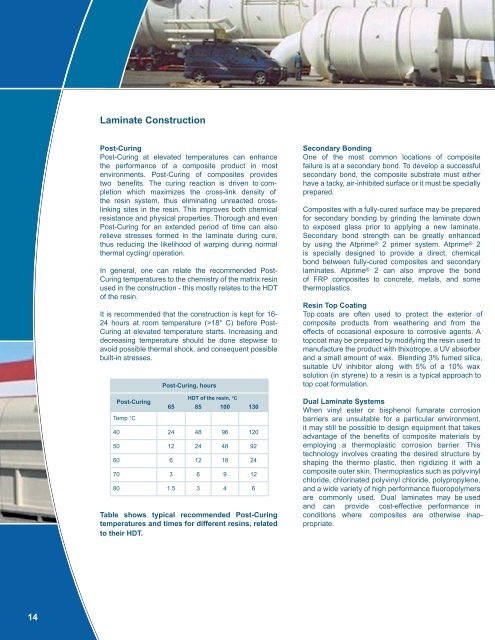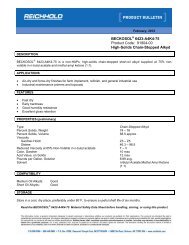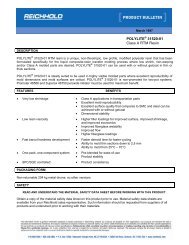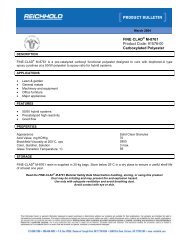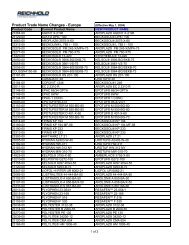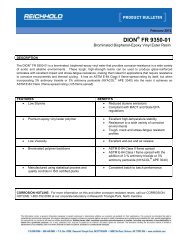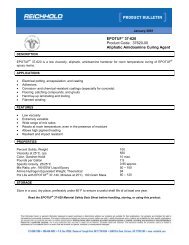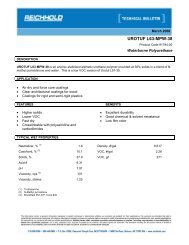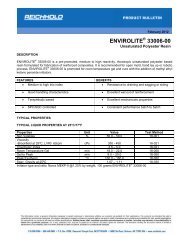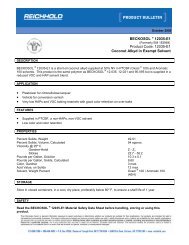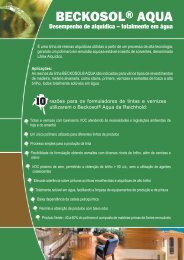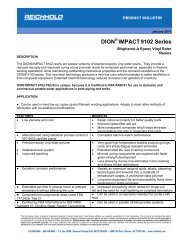CORROSION GUIDE 181108_new table content format ... - Reichhold
CORROSION GUIDE 181108_new table content format ... - Reichhold
CORROSION GUIDE 181108_new table content format ... - Reichhold
Create successful ePaper yourself
Turn your PDF publications into a flip-book with our unique Google optimized e-Paper software.
Laminate Construction<br />
Post-Curing<br />
Post-Curing at elevated temperatures can enhance<br />
the performance of a composite product in most<br />
environments. Post-Curing of composites provides<br />
two benefi ts. The curing reaction is driven to completion<br />
which maximizes the cross-link density of<br />
the resin system, thus eliminating unreacted crosslinking<br />
sites in the resin. This improves both chemical<br />
resistance and physical properties. Thorough and even<br />
Post-Curing for an extended period of time can also<br />
relieve stresses formed in the laminate during cure,<br />
thus reducing the likelihood of warping during normal<br />
thermal cycling/ operation.<br />
In general, one can relate the recommended Post-<br />
Curing temperatures to the chemistry of the matrix resin<br />
used in the construction - this mostly relates to the HDT<br />
of the resin.<br />
It is recommended that the construction is kept for 16-<br />
24 hours at room temperature (>18° C) before Post-<br />
Curing at elevated temperature starts. Increasing and<br />
decreasing temperature should be done stepwise to<br />
avoid possible thermal shock, and consequent possible<br />
built-in stresses.<br />
Post-Curing<br />
Temp °C<br />
Post-Curing, hours<br />
HDT of the resin, °C<br />
65 85 100 130<br />
40 24 48 96 120<br />
50 12 24 48 92<br />
60 6 12 18 24<br />
70 3 6 9 12<br />
80 1.5 3 4 6<br />
Table shows typical recommended Post-Curing<br />
temperatures and times for different resins, related<br />
to their HDT.<br />
Secondary Bonding<br />
One of the most common locations of composite<br />
failure is at a secondary bond. To develop a successful<br />
secondary bond, the composite substrate must either<br />
have a tacky, air-inhibited surface or it must be specially<br />
prepared.<br />
Composites with a fully-cured surface may be prepared<br />
for secondary bonding by grinding the laminate down<br />
to exposed glass prior to applying a <strong>new</strong> laminate.<br />
Secondary bond strength can be greatly enhanced<br />
by using the Atprime ® 2 primer system. Atprime ® 2<br />
is specially designed to provide a direct, chemical<br />
bond between fully-cured composites and secondary<br />
laminates. Atprime ® 2 can also improve the bond<br />
of FRP composites to concrete, metals, and some<br />
thermoplastics.<br />
Resin Top Coating<br />
Top coats are often used to protect the exterior of<br />
composite products from weathering and from the<br />
effects of occasional exposure to corrosive agents. A<br />
topcoat may be prepared by modifying the resin used to<br />
manufacture the product with thixotrope, a UV absorber<br />
and a small amount of wax. Blending 3% fumed silica,<br />
sui<strong>table</strong> UV inhibitor along with 5% of a 10% wax<br />
solution (in styrene) to a resin is a typical approach to<br />
top coat formulation.<br />
Dual Laminate Systems<br />
When vinyl ester or bisphenol fumarate corrosion<br />
barriers are unsui<strong>table</strong> for a particular environment,<br />
it may still be possible to design equipment that takes<br />
advantage of the benefi ts of composite materials by<br />
employing a thermoplastic corrosion barrier. This<br />
technology involves creating the desired structure by<br />
shaping the thermo plastic, then rigidizing it with a<br />
composite outer skin. Thermoplastics such as polyvinyl<br />
chloride, chlorinated polyvinyl chloride, polypropylene,<br />
and a wide variety of high performance fl uoropolymers<br />
are commonly used. Dual laminates may be used<br />
and can provide cost-effective performance in<br />
conditions where composites are otherwise inappropriate.<br />
14


